| Published
on 11
Oct
2008 |
All rights reserved.
|
|
|
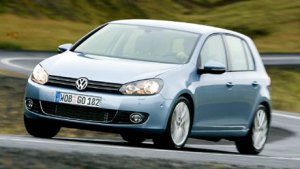
|
Golf VI is not really Golf VI. It is
Golf 5.5 at best...
|
34
years history, 5 generations, 26 million units sold, European No. 1
best seller... I suppose most of our readers are familiar with the
achievement of Volkswagen Golf. However, what made it so successful is
worth thinking. Though always been the benchmark of the family
hatchback class, the Golf has never been a trend setter or innovator.
Radical is not an adjective we would use to describe it. Build quality
? yes, undoubtedly good, but it is not the main reason people trusting
it, because it never came close to Japanese cars in quality surveys.
The key to its success is actually one word: Consistency. Look at its rivals,
sometimes stylish and sometimes ugly, sometimes radical and sometimes
conservative, sometimes great to drive and sometimes boring. No one
else in this class evolve consistently and stick to its core values
generation after generation like the Volkswagen. Like BMW 3-Series and
Porsche 911, it built a strong reputation through consistent evolution.
If consistency is good to Golf, then the latest evolution Golf VI must
be better than ever. You may remember the outgoing Mk5 presented an
unusually big leap forward. It brought a younger look, a classy
multi-link rear suspension (in response to Ford Focus), advanced
turbocharged direct-injection engines and double-clutch gearbox. It
drove so well that Wolfsburg considered a major upgrade would be
unnecessary this time. Therefore for the first time in its history, the
new generation Golf is built on the underpinnings of its predecessor.
Works are concentrated on new packaging, improving NVH and fine tuning
everything. In other words, Golf VI is not really Golf VI. It is Golf
5.5 at best, or I would describe it as a mid-life upgrade of Mk5.
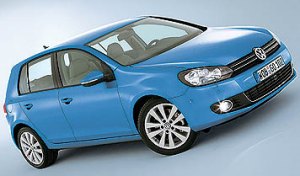
|
In the seas of radically styled new
cars, the conservative Golf is actually quite outstanding...
|
From
the pictures, you can see the same location of hard points resulted in
an identical shape to the last car, which looks too boxy these days.
Nevertheless, you may say conservatism works in line with the core
values of Volkswagen. In the seas of radically styled new cars, the
conservative Golf is actually quite outstanding. (There are more than
one ways to judge beauty) Moreover, a new horizontal grille and slim
headlamps reassembling Scirocco bring a classier image. In natural
sunlight it looks more elegant than in pictures. What a pity the rear
end doesn't look any more special despite of new horizontal taillights.
Volkswagen said 60 percent of all components are new to Golf VI. If
this were true, then most components must be used in the exterior and
interior packaging. Sometimes I don't quite understand how car makers
count the number of components. Sharing the engines, gearboxes,
steering and suspensions alone would contribute to more than 50 percent
of all components, so there must be some tricks in the counting.
Anyway, once you are in the cabin, you might forget that you are riding
on the Mk5 platform. Why ? Because the new Golf is ultra-refined. Its
ride is so smooth and quiet that you might assume you are in an
executive car. Wind noise, tire noise, suspension noise and engine
noise are barely audible. It sets new standard of refinement for the
C-segment. To achieve this, Volkswagen gave it new engine mounts,
quieter tires, extra sound deadening materials, more effective door
seals and thicker laminated glass.
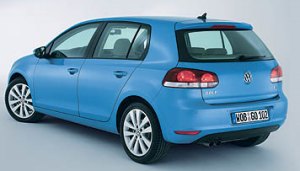
|
Volkswagen said 60 percent of all
components are new, I doubt...
|
The
cabin looks as conservative as exterior, but its build quality is
another upgrade from the already outstanding Mk5. Panel fit and finish
are better than ever. Soft-touch plastics cover even larger area.
Controls are made even higher quality and more ergonomical. You can
have very classy optional equipments, such as touch-screen infotainment
system, radar cruise control, rear-view camera and even an automatic
parallel parking system like Passat CC and Toyota Prius. As usual, the
seats are well shaped, multi-adjustable and comfortable. Space is still
competitive front and rear.
Although the new Golf shares the same underpinnings with Mk5, we can
hardly complain. Not many C-segment rivals employ independent
multi-link rear suspensions like it. Not many's electrical power
steering weighs as linear and deliver decent feel. Not many has a wide
range of advanced petrol and diesel engines. These include the
excellent 122hp 1.4 TSI direct injection turbo, 160hp 1.4 TSI direct
injection twin-charger and 2.0 TDI common-rail turbo diesel. The Golf
therefore combines great drivability, refinement and frugality.
Moreover, none of its rivals have 6-speed manual gearbox as standard
and offer 6 or 7-speed DSG gearbox as option.
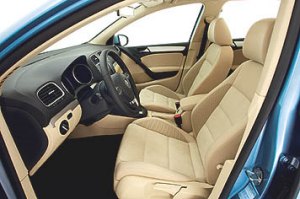
|
What makes the new Golf special is its
ultra-refinement...
|
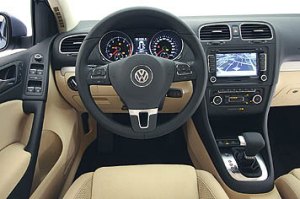 |
|
Our
pick of the range is the 160 hp 1.4 TSI twin-charger. Compare with the
same unit in Golf V, it lost 10 horsepower at the top end but none of
its tractability. It still produces 177 lb-ft of torque from 1500-4500
rpm, which enables a flexible driving character and relaxed motorway
cruising. Equipped with 7-speed DSG gearbox, it can accelerate from
rest to 60 mph in 7.6 seconds. Most amazing, its EU combined fuel
consumption figure is improved from the old car's 39 mpg to 47 mpg,
while CO2 emission is reduced from 174 to
139 g/km !
In curves, the Mk6 Golf retains the fine handling of Mk5, with
excellent body control, composed ride and a secured feel. Optional
adaptive damping (like Scirocco) improves things a little - sharper in
Sport mode and softer in Comfort mode - although Ford Focus still feels
sportier and more communicative. However, what makes the new Golf
special is its ultra-refinement. Everything happens smoothly and
quietly. It deserves to be called a junior executive car.
|
Verdict:      |
Published
on 2
Jun 2009
|
All rights reserved.
|
|
Golf GTI
|
|

|
Mk6 GTI is no quantum leap from Mk5...
|
Volkswagen
tells us this is the 6th generation Golf GTI. Pardon ? What’s new in it
?
If you talk about styling, I would say the new car is just a Mk5 with
a facelifted nose and new taillights. I doubt if these subtle
changes can differentiate it enough from the rest of the range. While
the previous GTI had a prominent black mask to let you identify it from
distant, in
the new car you have to get close to spot its honeycomb mesh grilles or
the GTI logo or the different shape fog lamps or the
17-inch alloy wheels – ironically, the latter are carried over intact
from the
old car. After a brief attempt of youthful design, Golf GTI returns to
its conservative tradition.
The conservatism is even more apparent in the cabin. No one would get
excited about its dashboard design, which I find remarkably similar in
architecture to the ancient Mk2 Jetta available in China. Nevertheless,
if you can shift your attention from style to quality, you will easily
appreciate its classy materials, smooth switchgears and unrivalled fit
and finish. The GTI’s bucket seats might look more classical than
stylish, but they are very supportive. Driving position is
spot-on, and the flat-bottom steering wheel is nice to hold. We only
hope the driver seat can be mounted a couple of inches lower, like that
in Scirocco.
Volkswagen stresses that the engine of GTI is a new one with codename
EA888, first debuted in Audi last year. It is said to have a stiffer
yet lighter
block and stronger internals to withstand higher stress. However, I
find its specifications not that different from the old 2.0 TFSI
engine. Capacity is still 1984cc, thanks to the same bore and stroke
dimensions. It also employs the same technologies as the old engine –
intake variable valve timing, variable intake manifolds, direct
injection and low-inertia turbo. The rumored Valvelift mechanism is not
available here, unlike the Audi version of EA888. Even the output
figures are remarkably close to the outgoing GTI engine – horsepower
barely
increases from 200hp at 5100 rpm to 211hp at 5300 rpm, while peak
torque remains at 206 lb-ft, although it arrives 100 rpm earlier and
last 200 rpm later. Gearbox is still that 6-speed manual or DSG
twin-clutch.
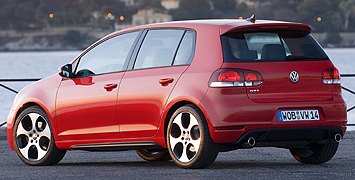
|
... but it is still the most sensible
choice for most people.
|
That
means the new GTI is faster
than the old car by a margin hardly perceptible in real world. We are
talking about 149 mph versus 146 mph, or 6.6 sec versus 6.8 sec for
0-60 mph sprint. However, you do feel the new engine a little bit
keener at low rpm, and smoother and quieter in the better insulated
cabin of Mk6. Few four-cylinder engines possess these qualities –
eager, refined and highly flexible. It pulls consistently
from as little as 1500 rpm and keeps spinning freely all the way to
7000 rpm cut-out. It is also remarkably fuel efficient, delivering 38.6
mpg in
European combined cycle.
The chassis has a similar all-round character. Though more relaxed and
refined than ever, it still displays excellent grip, fine body control,
good balance and a predictable handling. The steering remains accurate
and well-weighted, if not the sharpest. Compare with the old car, it is
slightly more responsive to turn-in. Maneuver in tight corners is
also tidier, thanks to the new XDS electronic differential – a
brake-based pseudo
limited slip differential like Alfa Q2 and Fiat/Lancia’s TTC – which
applies soft braking at the inside wheel to transfer more power to the
outside wheel, reducing understeer and wheel spin. It works
surprisingly well in reality.
However, to show the superiority of Mk6, you will probably need to pay
for the optional ACC Adaptive Chassis Control, which came standard in
Scirocco. Its key element is continuous adaptive damping suspension.
Three modes are offered: Normal is the truly adaptive mode which works
best under most circumstances. Comfort and Sport modes offer slightly
more extreme ride and handling at either sides of Normal. These modes
also link to throttle response and steering weighting to deliver a
noticeable change of character.
As before, Golf GTI is not meant to offer huge performance or the
sharpest
handling. It won’t beat Ford Focus RS or Mitsubishi Lancer Evo as a
B-road thriller, but it is definitely the more
sensible car for everyday driving, one that combines comfort,
refinement, economy, quality and taste at an affordable price. At the
same
time, it still offers solid performance and handling to satisfy 90
percent drivers. A quantum leap from its
predecessor it may not be, but given how good the old car was, it
actually doesn’t
need to change that formula.
|
Verdict:      |
Published on 23
Feb 2010
|
All rights reserved.
|
|
Golf R
|
|

|
Can the turbo four machine better than
its V6-powered predecessor ?
|
Tastefully
styled, impeccably built and powered by a marvelous V6 engine, the
outgoing Golf R32 was the most desirable hot hatch to me in the past
decade. Now having switched to a low-carbon four-pot turbocharged
engine and wrapped in the slightly less desirable clothes of Golf Mk6,
can the new generation Golf R better its predecessor ? It is quite
doubtful to me.
Yes, I know the German would not have introduced the new car if it
could not achieve higher performance and better handling again. In
fact, the Golf R has 270 horsepower and 258 lb-ft of torque on tap, 20
hp and 22 lb-ft more than R32. Its engine comes straight from Audi S3,
which means it is based on the older EA113 unit instead of the EA888 of
Golf GTI because the latter is not robust enough. Power aside, the
four-cylinder turbo engine is lighter than the old V6. In addition to
other optimization, the whole car is 70 kg lighter than before. 0-60
mph acceleration is cut by nearly a second to 5.5 seconds. In case of
DSG gearbox, the new record is 5.3 seconds compared to the previous 6.2
sec. Although I don't believe such figures can be easily repeated in
real world, the new car is still decisively faster than R32 without
question. It is greener too, with 199 grams of carbon-dioxide emitted
per kilometer, down from 257 g.
What it can't quite emulate is the smoothness, clean throttle response
at very low rev and the sound quality of the narrow-angle V6. By the
standard of high performance four-cylinder engines, this one is
remarkably refined - strangely, more so than the one installed to Audi
S3. However, in terms of subjective qualities, a four-cylinder will
never match a well-tuned six-cylinder engine, especially is one as good
as the old VR6. Sadly, Volkswagen group is phasing out the VR6 for the
better of its fleet emission - and by the way save costs. Consequently,
the bloodline dated back to the Mk3 Golf VR6 has finally come to an end.
The Golf R also looks less elegant than R32. Its enlarged cooling
intakes at both sides of the front bumper look a little rough, and the
thin grille (like all Mk6 Golf) is no where as special as the chromed
mask of R32. Elsewhere, both cars look similar. Their tails are
distinguished from lesser Golfs by centrally-mounted twin-exhaust. Both
cars employ 18-inch alloy wheels, one inch larger than GTI's, and
larger brakes consisting of 345mm and 310mm discs front and rear. As
expected, the suspension is lower and stiffer than GTI's. What's new is
the availability of adaptive damping and ACC adaptive chassis control.
The latter provides one switch to alter suspension firmness, steering
weighting and throttle response altogether.

|
Despite of faster reaction, the new
4motion does not entertain like Evo or STi...
|
As
before, the most powerful Golf needs all-wheel drive to tame its power,
so 4motion is standard. This explains why it is heavier than GTI by 127
kilograms. The latest, fourth generation Haldex multi-plate clutch
system is more responsive than the previous one. Previously, its
hydraulic pressure was built by a mechanical pump driven by the speed
difference between the input and output shafts, so there is no torque
transfer when the rear wheels do not slip. The new system functions the
same way, but its hydraulic pressure is built by an electric pump and
assisted by a high-pressure accumulator so that, when the electronics
detect the rear wheels slip, the multi-plate clutch can engage much
more quickly with the readily available oil pressure. What it doesn't
change is the way it transfers torque in normal condition - without
tire slip, all the torque goes to the front wheels.
On the road, the Golf R still feels like a front-wheel drive machine.
However, find a twisty road and push it harder, its 4motion starts to
make sense. Compare with Golf GTI, it displays slightly less understeer
and more enthusiasm to turn into corners. Its added traction and lack
of torque steer give you confidence to attack corners at higher pace.
Ditto the tighter body control and powerful braking. Nevertheless, the
4motion does not allow 4-wheel drift like Evo or STI. It is not as
entertaining to drive as a result. In fact, you may find the lighter,
two-wheel-drive Scirocco R deliver a sharper driving experience.
Oddly, the Golf R is more about covering back roads with comfort and
refinement of a premium car. Compare with boy racer cars like Ford
Focus RS and Renault Megane RS, its ride is smoother and its cabin is
much quieter. On highway, its 225/40 tires generate no more noise than
the Golf GTI, which is no small achievement. On the downside, the Golf
R never feels as fast as it should. Despite of those eye-popping 0-60
mph figures, in real world it doesn't feel as powerful as the
aforementioned Ford and Renault. As Autocar magazine found out in a
comparison test, it is comprehensively outclassed by its rivals for
pure acceleration. CAR magazine questioned whether it is sufficiently
better than Golf GTI to justify its £30,000-plus price tag, which
is 30 percent dearer before you add the most-wanted leather sports
seats and DSG gearbox. The same can be said to the previous R32, but I
would say the latter's V6 engine and more elegant design fulfill the
job of a premium performance hatch better. The new R, satisfy neither
the keenest drivers nor image chasers. |
Verdict:     |
| Published
on 27
May
2011 |
All rights reserved.
|
|
Golf Cabriolet
|
|

Golf Cabriolet used to be
the most popular open-top 4-seater in the world. According to
wikipedia, Volkswagen sold over 600,000 units of Golf Cabriolet from
1979 to 2002. This would be seen as a dream come true to any other car
makers. Not Volkswagen. Ridiculously, the Golf Cabriolet was never
given the internal respect (hence investment) it deserved. One should
remember that it was not the own son of Wolfsburg, but the brainchild
of
Karmann. The latter was also responsible for its assembly throughout
the years. Because of the slimmer profit margin, Volkswagen did not
find the motivation to update it in sync with the regular Golf.
Consequently, the Cabriolet was only ever available in Mk1 and Mk3
body, skipping Mk2 and Mk4. That is why in many people's mind the car
was somewhat associated with an outdated image.
Now the situation is over. As Karmann got bankrupted two years ago,
Volkswagen took back the initiative of its development and production.
It even acquired the Osnabrück plant from Karmann for the assembly
of the new Golf Cabriolet, which is based on the latest Mk6 platform.
Driving dynamics is guaranteed by its multi-link suspensions,
torque-vectoring braking, DSG gearbox, and the excellent range of TSI
and TDI engines. Interior build quality is the best in the industry, as
you can expect for a Golf variant. Therefore we can concentrate our
inspection to the fabric roof system and the chassis conversion from
tin top to open top.
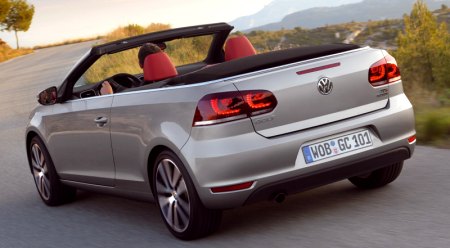
Style-wise, this car is easily the best looking Golf Cabriolet ever.
Not only it has a faster and lower windscreen than other Golfs to
promote a sportier look, but the roof system is finally integrated
flawlessly with the chassis. Previous Golf Cabriolets had a roll-over
hoop in place of B-pillars to provide the necessary chassis strength.
Looking like a basket handle, it was an eye sore when the roof dropped
down. Thanks to the chassis reinforcement at invisible locations, the
new car can have the roll-over hoop discarded, leaving a clean shoulder
line running straight from the windscreen to the tail. Moreover, unlike
Audi A3 Cabriolet and Mini Convertible,
the Golf Cabriolet does not have fixed roll-over hoops behind the rear
headrests. Its roll-over protection bars are stowed invisibly behind
the cabin and pop out only when the car flips. This makes its
appearance
sleeker and more upmarket than its counterparts, and reminds me of the
old Peugeot 306 Convertible.
The engineering of the soft top is beyond criticism. It opens in a
remarkable 9.5 seconds, can be operated at speed up to 30 km/h and,
when it is up, insulates noise and heat as well as the retractable
metal roof of VW Eos. Boot space is a reasonable 250 liters regardless
of the position of roof. It eats little into the cabin too. The rear
seats are roomy enough for sub-six footers to sit all day, thanks
partly to the concave front seatbacks and arm rests. Moreover, the rear
seatbacks are properly angled, unlike many so-called 4-seater
cabriolets which straight up their seatbacks to make room for soft top
storage.
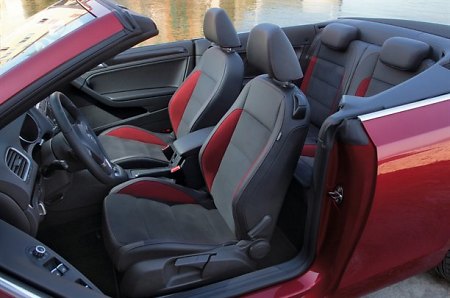
On the road, the driving experience is close to flawless. The
structural reinforcement made to windscreen frame, underbody cross
members, side panels and doors made the chassis impressively stiff.
Apart from a little body flex over poor surfaces and a little earlier
appearance of understeer, the Cabriolet handles and rides as well as
the hatchback. There is no squeaks and rattles at all. On highway with
the roof up, wind, road and suspension noise are subdued. Its quietness
and refinement are class-leading.
Furthermore, the conversion from tin top to soft top adds only 140 kg
to the kerb weight. This mean a mid-level 1.4 TSI twin-charger engine
with 160 horsepower is already sufficient to offer spirited
performance, let alone the range-topping 211 hp 2.0 TSI engine. Less
demanding drivers may consider the rest of the range: 105hp 1.2 TSI,
105hp 1.6 TDI, 122hp 1.4 TSI and 140hp 2.0 TDI. None of them are pigs.
However, the best news is pricing. Despite of its class-leading roof,
refinement and build quality, the Golf Cabriolet still undercuts Eos,
A3 Cabriolet and 1-Series Cabriolet by a large margin. That's a lot of
car and sophistication for the money ! I have no doubt that it will
extend the successful history the last two generations enjoyed. Karmann
or not is just irrelevant.
|
Verdict:      |
|